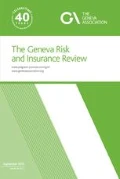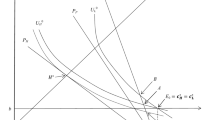Abstract
Both Akerlof (1970) and Rothschild and Stiglitz (1976) show that insurance markets may “unravel”. This memo clarifies the distinction between these two notions of unravelling in the context of a binary loss model of insurance. I show that the two concepts are mutually exclusive occurrences. Moreover, I provide a regularity condition under which the two concepts are exhaustive of the set of possible occurrences in the model. Akerlof unravelling characterises when there are no gains to trade; Rothschild and Stiglitz unravelling shows that the standard notion of competition (pure strategy Nash equilibrium) is inadequate to describe the workings of insurance markets when there are gains to trade.

Similar content being viewed by others
Notes
As discussed below, Riley (1979) shows this is true in the case when the support contains an interval; I show below this is also the case when the support is discrete but includes the point p=1.
The model is adapted from Hendren (2013), which derives the no-trade condition analogue of Akerlof in the binary loss environment but does not provide any discussion of competitive equilibriums.
To my knowledge, Riley (1979) was the first paper to discuss this environment with a continuum of types.
In contrast to Rothschild and Stiglitz (1976), I allow the insurance companies to offer menus of consumption bundles, consistent with the real-world observation that insurance companies offer applicants menus of premiums and deductibles.
If pH<1, then Eq. (1) would be violated at pH=1 by the assumption of strict concavity of u.
See Theorem 3 in Section 4, pages 341–343.
In the modified models of competition, proposed by Miyazaki (1977), Wilson (1977) or Spence (1978), such gains to trade will be realised in equilibrium.
References
Akerlof, G. (1970) The market for lemons: Qualitative uncertainty and the market mechanism, Quarterly Journal of Economics 84 (3): 488–500.
Hendren, N. (2013) Private information and insurance rejections, Econometrica 81 (5): 1713–1762.
Miyazaki, H. (1977) The rat race and internal labor markets, The Bell Journal of Economics 8 (2): 394–418.
Riley, J. (1979) Informational equilibrium, Econometrica 47 (2): 331–359.
Rothschild, M. and Stiglitz, J. (1976) Equilibrium in competitive insurance markets: An essay on the economics of imperfect information, The Quarterly Journal of Economics 90 (4): 629–649.
Spence, A. (1978) Product differentiation and performance in insurance markets, Journal of Public Economics 10 (3): 427–447.
Wilson, C. (1977) A model of insurance markets with incomplete information, Journal of Economic Theory 16 (2): 167–207.
Author information
Authors and Affiliations
Rights and permissions
About this article
Cite this article
Hendren, N. Unravelling vs Unravelling: A Memo on Competitive Equilibriums and Trade in Insurance Markets. Geneva Risk Insur Rev 39, 176–183 (2014). https://doi.org/10.1057/grir.2014.2
Received:
Accepted:
Published:
Issue Date:
DOI: https://doi.org/10.1057/grir.2014.2




